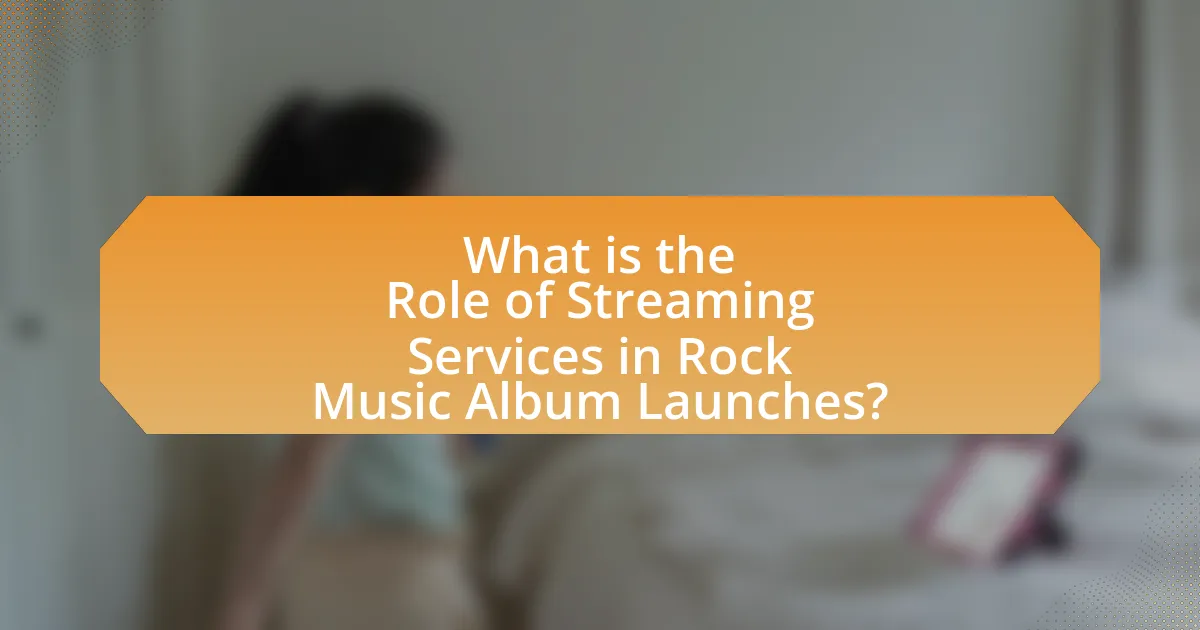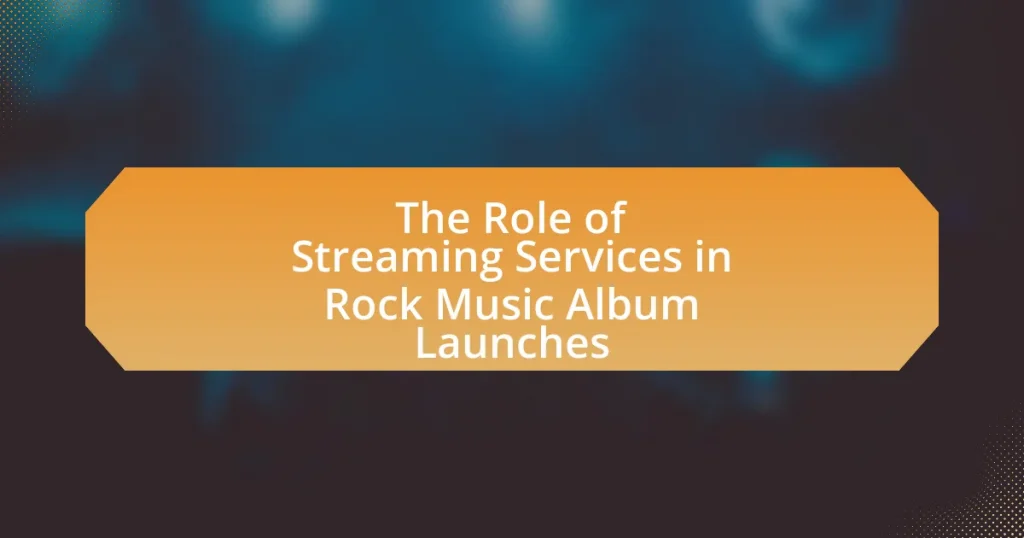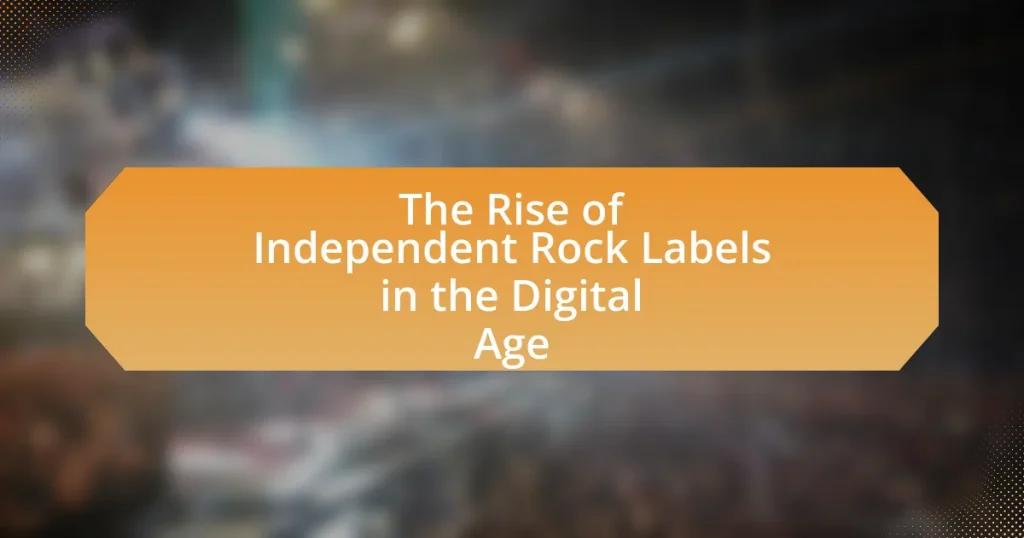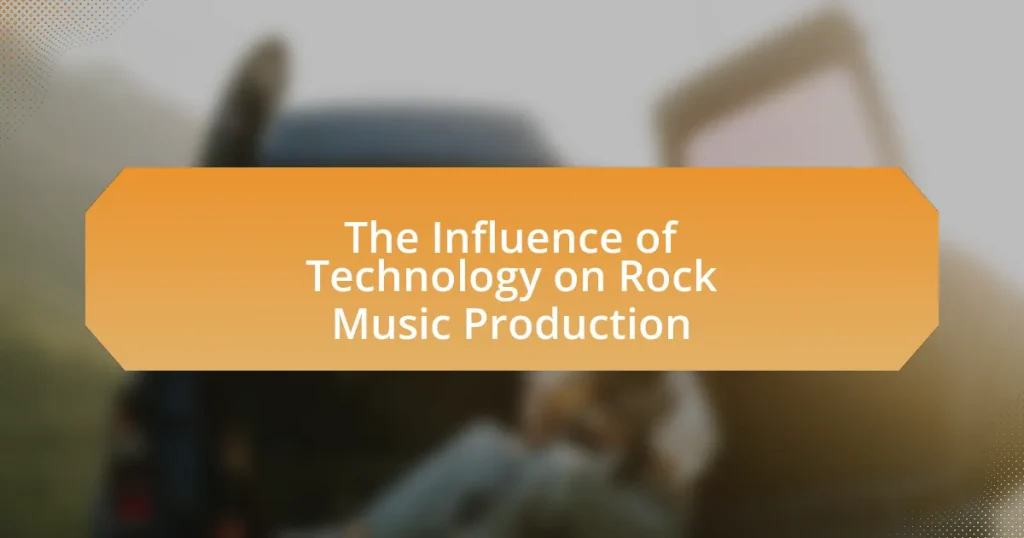Streaming services, such as Spotify and Apple Music, play a pivotal role in the launch of rock music albums by providing immediate global access to new releases, enhancing visibility, and maximizing audience engagement. These platforms have transformed traditional album release strategies, allowing artists to utilize features like curated playlists and real-time analytics to optimize their marketing efforts. The article explores how streaming services influence album launch timing, the challenges artists face regarding revenue and visibility, and the strategies that both new and established rock artists can employ to leverage these platforms effectively. Additionally, it discusses future trends and best practices for maximizing album success in the evolving digital landscape.

What is the Role of Streaming Services in Rock Music Album Launches?
Streaming services play a crucial role in rock music album launches by providing immediate access to new releases, thereby maximizing audience reach and engagement. These platforms, such as Spotify and Apple Music, allow artists to distribute their music globally within hours of release, significantly reducing the time and cost associated with traditional physical distribution methods. Additionally, streaming services often feature curated playlists and promotional tools that can enhance visibility for new albums, leading to increased streams and potential chart success. For instance, a study by the International Federation of the Phonographic Industry (IFPI) in 2021 indicated that over 70% of music consumption now occurs through streaming, underscoring its importance in the modern music landscape.
How have streaming services changed the landscape of album launches in rock music?
Streaming services have significantly transformed the landscape of album launches in rock music by enabling immediate global access to new releases. This shift allows artists to reach a wider audience instantly, as platforms like Spotify and Apple Music facilitate the release of entire albums simultaneously rather than relying on traditional promotional cycles. For instance, in 2020, the release of rock albums such as “The New Abnormal” by The Strokes saw immediate streaming success, reflecting how these platforms can drive rapid listener engagement. Additionally, streaming services have altered marketing strategies, with artists often releasing singles ahead of album drops to generate buzz, a tactic that has become increasingly common in the rock genre.
What are the key features of streaming services that impact album launches?
Key features of streaming services that impact album launches include playlist placements, algorithm-driven recommendations, and real-time analytics. Playlist placements on popular streaming platforms can significantly boost an album’s visibility and streaming numbers, as evidenced by the fact that tracks featured on major playlists can see a 10-fold increase in streams. Algorithm-driven recommendations personalize user experiences, leading to higher engagement and discovery of new albums, which is crucial for artists aiming to reach wider audiences. Additionally, real-time analytics provide artists and labels with immediate feedback on listener engagement and demographics, allowing for targeted marketing strategies that can enhance album launch success.
How do streaming platforms influence the timing of album releases?
Streaming platforms significantly influence the timing of album releases by allowing artists to strategically schedule their launches for maximum visibility and engagement. These platforms provide data analytics that help artists and labels identify optimal release dates based on listener trends, peak streaming times, and competitive landscape. For instance, major releases are often timed to coincide with weekends or holidays when listener engagement is typically higher, as evidenced by the spike in streams during these periods. Additionally, platforms like Spotify and Apple Music often feature new albums prominently on their homepages or playlists, which can drive significant traffic and streams, further incentivizing artists to align their release schedules with these promotional opportunities.
Why are streaming services essential for rock music artists today?
Streaming services are essential for rock music artists today because they provide a primary platform for music distribution and audience engagement. These services, such as Spotify and Apple Music, allow artists to reach a global audience instantly, which is crucial in an industry where traditional sales methods have declined. According to the Recording Industry Association of America (RIAA), streaming accounted for 83% of the U.S. music industry’s revenue in 2022, highlighting its dominance over physical sales and downloads. This shift enables rock artists to gain visibility, connect with fans, and generate income through streaming royalties, making these platforms vital for their success in the modern music landscape.
What advantages do streaming services provide to new rock artists?
Streaming services provide new rock artists with increased visibility and access to a global audience. These platforms allow artists to distribute their music widely without the need for traditional record label support, enabling them to reach listeners across different regions and demographics. For instance, Spotify reported that over 365 million users engage with its platform, which includes a significant number of potential fans for emerging artists. Additionally, streaming services often feature algorithms that promote new music based on user preferences, further enhancing discoverability. This data-driven approach allows new rock artists to gain traction and build a fan base more efficiently than through conventional methods.
How do established rock bands leverage streaming services for album launches?
Established rock bands leverage streaming services for album launches by utilizing exclusive releases, promotional playlists, and social media integration to maximize reach and engagement. For instance, bands often release singles exclusively on platforms like Spotify or Apple Music prior to the full album launch, creating anticipation and driving traffic to their profiles. Additionally, they collaborate with streaming services to feature their music on curated playlists, which can significantly increase visibility; for example, a song featured on Spotify’s “Today’s Top Hits” playlist can reach millions of listeners. Furthermore, established bands use social media to promote their streaming links, often engaging fans with behind-the-scenes content or live Q&A sessions, enhancing their connection with the audience and encouraging streaming. This multi-faceted approach not only boosts initial streaming numbers but also contributes to sustained interest in the album post-launch.
What challenges do rock artists face with streaming services during album launches?
Rock artists face significant challenges with streaming services during album launches, primarily due to revenue distribution and visibility issues. The revenue model of streaming platforms often results in lower payouts per stream, which can adversely affect artists’ earnings compared to traditional album sales. For instance, a report from the Music Industry Revenue Report indicates that artists receive an average of $0.003 to $0.005 per stream, making it difficult for rock artists to sustain their careers solely through streaming income. Additionally, the algorithms used by streaming services can limit the visibility of new releases, as they often prioritize established artists or popular playlists over new rock albums, making it challenging for emerging or niche rock artists to gain traction. This combination of low revenue and limited exposure creates a difficult environment for rock artists during album launches.
How do revenue models of streaming services affect rock music artists?
Revenue models of streaming services significantly impact rock music artists by altering their income streams and exposure. Streaming platforms primarily operate on subscription and ad-supported models, which result in lower per-stream payouts compared to traditional album sales. For instance, in 2021, the average payout per stream was approximately $0.003 to $0.005, meaning artists need millions of streams to earn a sustainable income. This shift has led many rock artists to rely more on live performances and merchandise sales for revenue, as streaming alone often does not cover production and marketing costs. Additionally, the algorithms used by these platforms can favor popular tracks, making it challenging for emerging rock artists to gain visibility, thereby affecting their overall career growth and financial stability.
What are the implications of streaming service algorithms on album visibility?
Streaming service algorithms significantly influence album visibility by determining which albums are promoted to users based on their listening habits and preferences. These algorithms prioritize content that aligns with user behavior, often favoring popular or trending albums, which can lead to a disparity in exposure for new or less mainstream releases. For instance, a study by the University of Southern California found that playlists curated by algorithms can account for up to 70% of streams for new music, highlighting the critical role these algorithms play in shaping listener access to albums. Consequently, artists and labels must understand and navigate these algorithms to enhance their album’s visibility in a competitive digital landscape.
How do streaming services collaborate with rock artists for album promotions?
Streaming services collaborate with rock artists for album promotions by providing targeted marketing strategies, exclusive content, and playlist placements. These platforms often create promotional campaigns that include pre-release singles, artist interviews, and behind-the-scenes footage to engage fans. For instance, Spotify has been known to feature rock albums prominently on its homepage and in curated playlists, which significantly increases visibility and streaming numbers. Additionally, services like Apple Music may offer exclusive album releases or live-streamed concerts, enhancing the promotional reach. Data shows that artists who leverage these collaborations can see a substantial increase in their album’s first-week streaming figures, demonstrating the effectiveness of such partnerships.
What strategies can rock artists use to maximize their album launch on streaming platforms?
Rock artists can maximize their album launch on streaming platforms by leveraging pre-release marketing, engaging with fans through social media, and utilizing playlist placements. Pre-release marketing, such as releasing singles or teasers, builds anticipation and can lead to higher initial streaming numbers. Engaging with fans on platforms like Instagram and Twitter fosters a community that is more likely to support the album upon release. Additionally, securing placements on popular playlists can significantly increase visibility; for instance, songs featured on Spotify’s “Rock This” playlist often see a substantial boost in streams, as playlists are a primary discovery tool for listeners.
How can social media integration enhance album launches on streaming services?
Social media integration can enhance album launches on streaming services by amplifying reach and engagement with target audiences. By leveraging platforms like Instagram, Twitter, and TikTok, artists can create buzz around their album releases through teasers, behind-the-scenes content, and interactive campaigns. For instance, a study by the International Journal of Music Business Research found that 70% of music consumers are influenced by social media when discovering new music, indicating that effective social media strategies can significantly increase streaming numbers and listener engagement. Additionally, artists can utilize social media to foster community interaction, encouraging fans to share their experiences and promote the album organically, which further drives traffic to streaming platforms.
What role do playlists play in the success of rock album launches?
Playlists significantly enhance the success of rock album launches by increasing visibility and engagement with target audiences. When a rock album is featured on popular playlists, it gains immediate access to a broader listener base, which can lead to higher streaming numbers and increased sales. For instance, a study by Nielsen Music found that tracks included in curated playlists can see a 30% increase in streams compared to those not featured. This exposure not only boosts initial album performance but also contributes to long-term listener retention and fanbase growth, as playlists often serve as discovery tools for new music.
What are the future trends for streaming services in rock music album launches?
Future trends for streaming services in rock music album launches include increased integration of augmented reality experiences and personalized marketing strategies. Streaming platforms are likely to leverage augmented reality to create immersive album launch events, enhancing fan engagement and providing unique experiences that traditional releases cannot offer. Additionally, data analytics will enable streaming services to tailor marketing efforts to individual listener preferences, optimizing promotional campaigns for specific demographics. This shift is supported by the growing trend of artists utilizing platforms like Spotify and Apple Music to directly connect with fans, as evidenced by the rise in exclusive content releases and live-streamed performances during album launches.
How might emerging technologies impact the way rock albums are launched on streaming platforms?
Emerging technologies will significantly enhance the way rock albums are launched on streaming platforms by enabling innovative marketing strategies and personalized listener experiences. For instance, advancements in artificial intelligence allow for targeted advertising based on user behavior, which can increase engagement and reach for new album releases. Additionally, virtual reality and augmented reality can create immersive experiences for fans, such as virtual album launch parties or interactive music videos, which can drive excitement and anticipation. Data analytics tools provide insights into listener preferences, allowing artists and labels to tailor their promotional efforts effectively. These technologies collectively facilitate a more dynamic and engaging album launch process, ultimately leading to higher streaming numbers and fan interaction.
What predictions can be made about the evolution of streaming services in the rock genre?
Streaming services in the rock genre are predicted to increasingly prioritize personalized user experiences and exclusive content. As data analytics improve, platforms will likely offer tailored playlists and recommendations that cater specifically to rock music fans, enhancing listener engagement. Additionally, the trend of exclusive album releases on streaming platforms, as seen with artists like Taylor Swift and Beyoncé, is expected to extend to rock artists, allowing them to leverage streaming for promotional strategies. This shift is supported by the fact that in 2022, rock music accounted for 20% of all streaming music consumption in the U.S., indicating a strong market presence that streaming services will continue to capitalize on.
What best practices should rock artists follow when launching albums on streaming services?
Rock artists should prioritize strategic marketing, audience engagement, and playlist placements when launching albums on streaming services. Effective marketing includes creating a pre-release buzz through social media campaigns, teasers, and engaging visuals, which can increase listener anticipation and drive initial streams. Engaging with fans through live streams, Q&A sessions, and exclusive content fosters a loyal community that supports the album’s release. Additionally, securing placements on popular playlists is crucial, as playlists significantly influence streaming numbers; for instance, being featured on Spotify’s “Rock This” playlist can lead to thousands of new listeners. These practices are supported by data showing that albums with strong pre-release marketing and playlist placements achieve higher first-week streaming numbers, enhancing overall visibility and success on streaming platforms.



